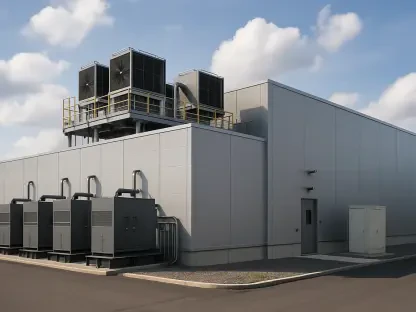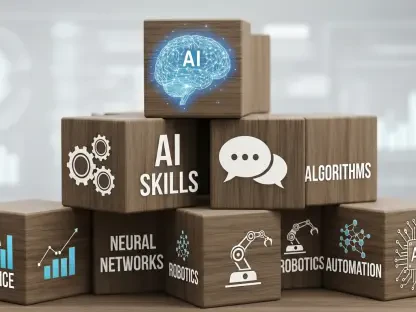The cloud computing arena is dynamic, with hybrid clouds emerging as a cornerstone, particularly with generative AI’s (GenAI) integration. Hybrid clouds leverage both private infrastructures and public cloud resources, creating a potent mix for businesses. This combination offers a pathway to utilize in-house data with the expansive capabilities of the public cloud, driving forward performance, innovation, and business agility. As we explore the relationship between GenAI and hybrid clouds, key aspects come to the forefront, including architectural intricacies, performance engineering, and strategic deployment methods. These elements are crucial for optimizing hybrid cloud functionalities and unlocking new potentials for enterprises. The harmonization of GenAI with hybrid cloud models is set to redefine business operations, shaping a future where flexibility and efficiency are at the forefront of technological advancements.
Redefining Hybrid Cloud in the Age of AI
Traditionally, a hybrid cloud has been viewed as the orchestration between private and public clouds. However, the boundaries have broadened, now encompassing an array of on-premises data centers, colocated facilities, and managed services all coalescing with public cloud services. This broadened perspective signals a transformation in strategy as enterprises strive to remain competitive without the hefty investment required for a solely public cloud structure. Such integration is increasingly critical due to GenAI’s data-hungry nature, necessitating seamless access to large datasets often housed within these diverse environments. Here, we analyze why enterprises are leaning toward this multifaceted hybrid approach, crafting a nuanced definition of a hybrid cloud that is both current and forward-looking.The transition to this expansive definition of hybrid clouds is driven largely by the desires to continue leveraging investments in on-premises infrastructure while avoiding the latency and control issues that can come with single-cloud adoption. This involves a strategic blend of localized control, compliance adherence, and scalable computing power from the public cloud. Garnering the ability to swiftly shuffle workloads to the most appropriate computing environment, organizations are redefining the hybrid cloud, creating a resilient, AI-competent infrastructure fabric.
Architectural Essentials for GenAI-Enabled Hybrid Clouds
As hybrid clouds integrate GenAI, a strong architecture is essential. Redundancy, load balancing, and fault tolerance are critical elements to consider, no longer just secondary thoughts. Redundancy provides backup components, load balancing ensures even workload distribution, and fault tolerance maintains smooth operation despite partial failures. These, coupled with caching for faster data access, form a resilient and effective hybrid cloud system geared for GenAI demands.Hybrid clouds must be dynamic and adaptable, especially for GenAI’s variable compute and storage needs. By embedding resilience into the hybrid cloud architecture, organizations create a suitable platform for AI processes. Redundancy prevents data loss, load balancing enhances resource use, and fault tolerance guarantees uninterrupted service, crafting an environment where GenAI can excel.
Navigating Performance Optimization in Hybrid Clouds
To realize the full potential of hybrid clouds, especially when used as a platform for GenAI applications, performance optimization is crucial. Establishing precise performance metrics that align with business objectives is the initial step toward performance authenticity. These metrics act as benchmarks, guiding the implementation of optimized design patterns, and a strategic application of resources to craft a performance-optimized environment fit for the demands of GenAI. These approaches, alongside proactive performance engineering, can dramatically enhance the responsiveness and agility of hybrid cloud infrastructures.In the terrain of AIOps, there lies the potential to dramatically transform the efficiency of hybrid clouds by employing AI to manage and optimize systems based on real-time data analysis and usage patterns. Deploying AIOps can bring about significant improvements in predicting and resolving performance bottlenecks even before they impact operations. Thus, a core element of performance optimization in hybrid clouds is the integration of intelligent ops tools, paving the way for a self-healing, self-scaling, and self-optimizing cloud environment that can support the rigorous demands of GenAI applications.
The Critical Role of Testing and Observability in Hybrid Clouds
To sustain high performance in hybrid clouds, intensive testing and continuous observability are crucial. These practices preempt problems, ensuring a robust infrastructure for GenAI workloads. Thorough testing—from load tests to stress checks—and ongoing monitoring uphold the integrity and adaptability of hybrid cloud systems. This is essential, not only for reliability but also to cater to the evolving landscape of hybrid clouds and GenAI demands.Observability is key to maintaining reliability, offering insights for a proactive stance on issue management. By merging solid test plans with observability, firms can secure their hybrid clouds’ immediate and long-term resilience. This strategy is vital for adapting to the swift changes in enterprise requirements and AI advancements, keeping hybrid clouds attuned to future challenges. These steps are imperative for an optimized, future-proof, and reliable hybrid cloud setup that supports emerging AI-driven workloads effectively.
Overcoming the Challenges of Multi-Cloud Operations
The intricate dynamics of multi-cloud environments, with data dispersed across numerous locations such as IoT devices, edge computing systems, and various cloud providers, present their own set of challenges. In this complex milieu, businesses must navigate the tangled web of operations to extract the maximum benefit from their hybrid cloud investments. Streamlining workflows and refining data management strategies is not a luxury but a necessity for organizations to harness the strengths of both hybrid clouds and GenAI effectively. This section explores how enterprises can circumvent typical obstacles associated with multi-cloud operations, highlighting the importance of coherent and efficient management practices.By focusing on cross-compatibility and devising comprehensive management solutions, businesses can synchronize the disparate components of their multi-cloud operations. This synergy is especially critical when integrating GenAI into the mix, where data fluidity and computational efficiency become paramount. It is through the harmonization of these multi-cloud components and a sound data governance strategy that enterprises can unlock the true potential of GenAI within hybrid clouds, ensuring seamless operation and paving the way for innovation and growth.
Moving Beyond Myths to Embrace Hybrid Cloud Strengths
Hybrid cloud architectures are often wrongly blamed for performance issues when, in truth, such problems are usually due to poor engineering or architecture, not the hybrid model itself. A well-designed and managed hybrid cloud can indeed meet efficiency and operational standards. It’s crucial for businesses to understand that with the right approach, a hybrid cloud can provide a powerful and adaptable infrastructure. This is particularly relevant when integrating cutting-edge technologies like GenAI, where a robust and flexible environment is key. The myth that hybrid clouds are inherently flawed needs to be dispelled, enabling organizations to leverage the full potential of these systems for growth and innovation. With proper planning and management, hybrid clouds can excel in the competitive cloud computing landscape.
Strategically Deploying Hybrid Clouds for Maximum GenAI Impact
In leveraging hybrid clouds with GenAI, a strategic and performance-driven approach is key. Proper exploitation of hybrid architectures can maximize GenAI’s potential. Enterprises must grasp the hybrid framework’s nuances and employ vigilant deployment methods to avoid common setbacks. A thorough deployment plan, enriched by a deep understanding of GenAI intricacies, empowers organizations to fully utilize the hybrid cloud’s extensive perks.By strategically incorporating GenAI within hybrid environments, businesses can amplify their operations and tackle both the opportunities and the known challenges head-on. With disciplined implementation and careful management, the pathway to innovative breakthroughs is opened, supported by the harmonious fusion of hybrid clouds and generative AI tech. Through this, organizations enter a new era of innovation, where hybrid clouds and GenAI operate in a complementary fashion.









